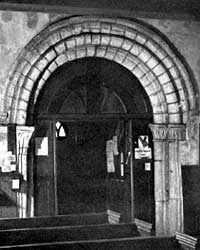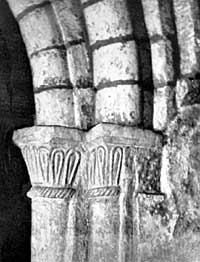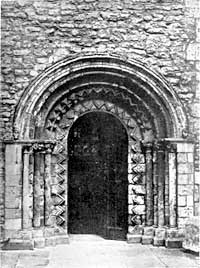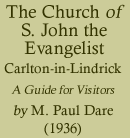Tower interior

LATE-SAXON TOWER ARCH EAST FACE.

LATE-SAXON TOWER ARCH. DETAIL OF NORTH PIER.
Noticing the well-preserved quoins (corner-stones) of the Norman nave end, in which the tower is slightly enclosed, on north and south, we can now go inside. Here at the time of writing, a horrible mess meets the eye. In the right-hand corner opposite the entrance-door there rises an enormous deal cupboard, built to house the clock weights. On the left arises an equally hideous staircase which leads up, through a door cut through the east wall of the tower, to give access to a gallery at the west end of the nave.
This atrocity is early 19th century work, and if funds be available after the roof restoration, the removal of all this timber-yard is one of the next necessities. It is not historical, and it entirely conceals the western face of the Anglo-Saxon tower arch, the piers of which are very plain and stand on rough-hewn projecting bases ; they are best inspected by opening the cupboard on the right, where also the eye can follow the outline of the arch springing from the pier, masked by the modern boarding over the uniquely ugly screen which, efficient though it be as an anti-draught device, more resembles the entrance to a fish-and-chip saloon than anything ecclesiastical.
In the south-west corner of the tower, on the right hand, note the entrance (a depressed Perpendicular arch) to the round stone newel stair of the tower, built about 1425 to reach the then new bell-storey. Before that time, the upper floors would be reached by loft ladders, pulled up when the tower was used as a refuge. It is probable, to judge by other known examples, that the Anglo-Saxon church had a small window over the tower arch, and that the present doorway to the gallery, pierced in the thickness of the wall, takes its place. In the tower is an early 18th century chest with the usual three locks for rector and wardens.
Passing through into the nave, we are able to see the tower arch to better advantage, and to gain a very good idea of later Saxon architecture. Its eastern face is more elaborate than the western, being semicircular-headed and composed of two recessed orders, the arches bearing heavy roll-mouldings and springing from engaged round shafts. The capitals of these shafts are worth noticing for their unusual ornament, being best described as a degraded variation of the Roman motif known as the " tongue." Crude perhaps to the modern eye, it is yet satisfying and, in its naive simplicity, in keeping with the rest of the tower. The neck of the capitals has a cable moulding, an ornament found both in Saxon and Norman work, and the narrow entrance, measuring but 6' 10" between the piers, is typical of Saxon entrance measurements.
Dates of the tower

NORMAN DOOR, c. 1160—NOW WEST ENTRANCE TO TOWER; MOVED FROM NAVE SOUTH WALL IN 1831.
Here a few notes are necessary on the probable dates of the tower, for the dating of Anglo-Saxon work has not been brought to a fine science ; one cannot dogmatise on it, and the best one can do is to suggest the most probable date based on the style and quality of the work, other known examples, and the political conditions of that disturbed age. The shell and windows of the tower (except its late top stage) are the earliest parts. The arch-construction of the opened window bears all the characteristics of the crudest and earliest Saxon work. The arch is formed of wedge-shaped voussoirs irregularly laid slat-wise and serrated like a Venetian blind, and merely faced externally with a single block of stone to each head, cut semicircular. If there were such stones internally, they have gone.
The great central stone between the heads is chamfered and forms one huge impost, which rests on the shaft without any intervening capital—a variation in England of the corbelling-out which is a feature of the early Continental "Visigoth" work. Another early feature is that the shaft neither tapers nor has entasis (bulging) at the centre.
The base of the shaft is a rough, bulbous swelling ; and a curious feature of the whole window is that it is not properly splayed, but simply set askew in the wall. The external window-heads, with a very slight slope outwards of the jambs, give a " keyhole " outline, which is found in a more pronounced form at Clee, near Grimsby. The window is 7' 2" high, 4' 4" wide ; each light is 1' 8" wide, and the shaft is 1' 0" in diameter. The central cap-stone seems to have had an interior projection, like a corbel, lopped off.
All it is possible to say about the date of the windows and the shell in which they stand is that the tower may be put down as before 860 A.D., and that it may even be as early as 692-702, the date of the unhappy Wilfrid's third period of exile from his Northumbrian see, during which time he served as a bishop in Mercia and was active in building churches. The nave of Brixworth, Northants., is probably his work, and the amateur arch-construction at that church is almost identical with that of our window.
The next few decades after 850 were an impossible time for church-building, owing to the constant Danish raids, and wholesale destruction of churches and monasteries. By 874 the Danes had seized the whole Trent valley, had sacked York, subjugated both Mercia and Northumbria, and had all England at their feet. Only then did they start to settle down, and to be more tolerant, cultivating the land round York and granting at last a refuge to the bones of S. Cuthbert, which for years had been hauled round the wild north by fugitive monks fleeing from fire and sword. Repton itself, capital of Mercia and the religious cultural centre of this district, fell in 873-4.
Getting into the 10th century, we find the work of this time far less crude than that of the Carlton tower window.
Considering all these factors, and bearing in mind that not so far away, in Leicestershire, was the monastery of Breedon, whose fine series of sculptures has been proved to date not later than 850 and probably nearer 750, there is nothing unreasonable in suggesting an 8th or early 9th century date for our tower, which is of far cruder calibre than the architecture of Breedon, to judge by its remaining sculptures, must have been.
The tower arch is much later than the windows — at least, its eastern face, the west face being very crude — and it would be unsafe to place it much earlier than about 1040-1050, since it shows the Romanesque influence which came in with the Confessor. Church work was steadily increasing at this time, and the enlargement or enrichment of the original entrance to the nave from the tower seems to have been the prelude to the general scheme of rebuilding the earliest nave. The Conquest may even have held up the scheme after the arch had been done.
